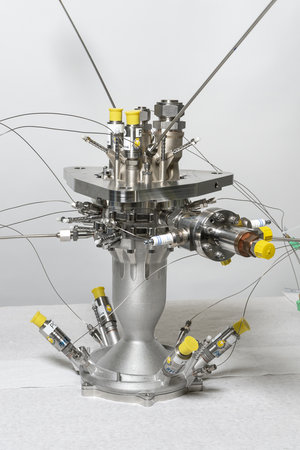Accept all cookies Accept only essential cookies See our Cookie Notice

About ESA
The European Space Agency (ESA) is Europe’s gateway to space. Its mission is to shape the development of Europe’s space capability and ensure that investment in space continues to deliver benefits to the citizens of Europe and the world.
Highlights
ESA - United space in Europe
This is ESA ESA facts Member States & Cooperating States Funding Director General Top management For Member State Delegations European vision European Space Policy ESA & EU Space Councils Responsibility & Sustainability Annual Report Calendar of meetings Corporate newsEstablishments & sites
ESA Headquarters ESA ESTEC ESA ESOC ESA ESRIN ESA EAC ESA ESAC Europe's Spaceport ESA ESEC ESA ECSAT Brussels Office Washington OfficeWorking with ESA
Business with ESA ESA Commercialisation Gateway Law at ESA Careers Cyber resilience at ESA IT at ESA Newsroom Partnerships Merchandising Licence Education Open Space Innovation Platform Integrity and Reporting Administrative Tribunal Health and SafetyMore about ESA
History ESA Historical Archives Exhibitions Publications Art & Culture ESA Merchandise Kids Diversity ESA Brand CentreLatest
Space in Member States
Find out more about space activities in our 23 Member States, and understand how ESA works together with their national agencies, institutions and organisations.
Science & Exploration
Exploring our Solar System and unlocking the secrets of the Universe
Go to topicAstronauts
Missions
Juice Euclid Webb Solar Orbiter BepiColombo Gaia ExoMars Cheops Exoplanet missions More missionsActivities
International Space Station Orion service module Gateway Concordia Caves & Pangaea BenefitsLatest
Space Safety
Protecting life and infrastructure on Earth and in orbit
Go to topicAsteroids
Asteroids and Planetary Defence Asteroid danger explained Flyeye telescope: asteroid detection Hera mission: asteroid deflection Near-Earth Object Coordination CentreSpace junk
About space debris Space debris by the numbers Space Environment Report In space refuelling, refurbishing and removingSafety from space
Clean Space ecodesign Zero Debris Technologies Space for Earth Supporting Sustainable DevelopmentLatest
Applications
Using space to benefit citizens and meet future challenges on Earth
Go to topicObserving the Earth
Observing the Earth Future EO Copernicus Meteorology Space for our climate Satellite missionsCommercialisation
ESA Commercialisation Gateway Open Space Innovation Platform Business Incubation ESA Space SolutionsLatest
Enabling & Support
Making space accessible and developing the technologies for the future
Go to topicBuilding missions
Space Engineering and Technology Test centre Laboratories Concurrent Design Facility Preparing for the future Shaping the Future Discovery and Preparation Advanced Concepts TeamSpace transportation
Space Transportation Ariane Vega Space Rider Future space transportation Boost! Europe's Spaceport Launches from Europe's Spaceport from 2012Latest
Pangea’s methalox aerospike engine – first in the world!
Thank you for liking
You have already liked this page, you can only like it once!
Spanish company Pangea Aerospace developed and tested the first aerospike engine in the world to run on liquid methane and oxygen. This video shows scenes of the engine being tested at the German aerospace center, DLR, test centre in Lampoldshausen Germany in 2021.
Unlike almost all rocket engines in operation, aerospike engines don’t have bell-shaped nozzles but plugs to eject their exhaust. This allows the engine to be more efficient at different altitudes, offering up to 15% more efficiency – and in rocket launches efficiency is everything as you try to escape Earth’s gravity. Aerospike engines have stayed theoretical for decades. Although a few were built in the 1980’s, new 3D-printing techniques have made them more economically viable
These scenes were taken from four test runs with the engine firing for around a minute during each test. Liquid methane and liquid oxygen – often abbreviated to methalox – is cooled down to around –170°C before being mixed and burnt in the engine, where the mixture then heats up to temperatures above 3000°C. To prevent the engine from melting, Pangea Aerospace’s design runs both the cryogenic methane and oxygen fluids around the engine to cool it. The test firing delivered up to 20 kilonewtons of thrust.
This engine development was supported in part by ESA’s Future Launchers Preparatory Programme, and Pangea Aerospace is also working with ESA to identify how to design and build a very high thrust rocket engine for future launchers – offering over 2 meganewtons of thrust.
-
CREDIT
Pangea Aerospace -
LICENCE
ESA Standard Licence
-
Closed captions available Captions and subtitles are available (automatically generated by YouTube) - select your language using the YouTube player controls. A non-YouTube version is available using the 'download' button above.
-
TV Exchanges
-
-

Firing up Arcos – the European aerospike engine

15th European Space Conference - Session 3

15th European Space Conference - Session 3

Thrust Chamber demonstrator















 Germany
Germany
 Austria
Austria
 Belgium
Belgium
 Denmark
Denmark
 Spain
Spain
 Estonia
Estonia
 Finland
Finland
 France
France
 Greece
Greece
 Hungary
Hungary
 Ireland
Ireland
 Italy
Italy
 Luxembourg
Luxembourg
 Norway
Norway
 The Netherlands
The Netherlands
 Poland
Poland
 Portugal
Portugal
 Czechia
Czechia
 Romania
Romania
 United Kingdom
United Kingdom
 Slovenia
Slovenia
 Sweden
Sweden
 Switzerland
Switzerland

























